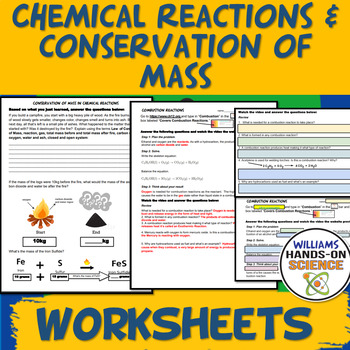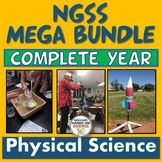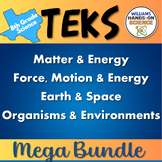Conservation of Mass Chemical Reactions NGSS MS-PS1-5 Digital
- Zip
- Google Apps™
- Internet Activities

Also included in
- This Chemistry Curriculum Physical and Chemical Changes NGSS Bundle has everything you need for Structure and Properties of Matter (complete distance learning unit), PS1.B PS3.A Chemical Reactions Google Ready Bundle (complete distance learning unit) Chemical Reactions, Definitions of Energy, StatesPrice $69.97Original Price $115.20Save $45.23
- This bundle is a time-saving, comprehensive and user-friendly complete year bundle for physical science Teachers that will streamline your teaching experience effortlessly! Every lesson is meticulously planned and just a click away. This extraordinary bundle is a treasure trove of engaging resourcesPrice $176.00Original Price $311.50Save $135.50
- The TEKS 8th Grade Bundle is a comprehensive resource for teaching science mainly in Texas, but it can be used in any state. This bundle includes over 60 hands-on, rigorous, engaging, and phenomena-driven lessons that cover the TEKS standards for 8th grade science. The lessons are designed to help sPrice $160.00Original Price $321.15Save $161.15
Description
This 60 minute online activity isn’t just rote fill in the blank busy work. It's engaging, challenging and no prep for you! It covers NGSS PS1.A and PS1.B Structure and Properties of Matter
Students need to read and think critically to find the answers! Because students tend to expect easy to find answers, the students will at first say they can’t find the answer. I just keep telling them to re-read because the answer is there. I also front load the lesson by telling them the answers aren’t all explicitly there, they have to read the passages multiple times and think critically. This is especially true for the last page. On the last page they use what they learned to answer, explain and apply the vocabulary to a campfire in the form of a paragraph.
There is no prep! All you have to do is print one per student and have access to 1 on 1 computers! Or you can assign it as homework or a sub-plan.
Students read several passages at a time, watch YouTube video clips, answer questions, do cloze notes about the videos and informational text. On the last page, students put content into context by applying Law of Conservation of Mass, chemical reactions, gas, total mass before and total mass after fire, carbon dioxide, oxygen, water and ash, closed and open system to the burning of a campfire in the form of a paragraph.
This product Includes the following:
-Student copy
-Answer Key
-Teacher directions
-Link to Google Copy for Distance Learning
-Google Classroom Tutorial
Includes the following concepts:
-The Law of Conservation of Mass
-Chemical Reactions
-Properties of Matter
-Evidence for Chemical Reactions
-Chemical Equations
-Reactants and Products
-Conservation of Mass
-Endothermic and Exothermic
-Open and Closed Systems
-Combustion
- Antoine Lavoisier
Includes the Following NGSS Standards:
PS1.A: Structure and Properties of Matter
Substances are made from different types of atoms, which combine with one another in various ways. Atoms form molecules that range in size from two to thousands of atoms.
Each pure substance has characteristic physical and chemical properties (for any bulk quantity under given conditions) that can be used to identify it.
PS1.B: Chemical Reactions
Substances react chemically in characteristic ways. In a chemical process, the atoms that make up the original substances are regrouped into different molecules, and these new substances have different properties from those of the reactants.
The total number of each type of atom is conserved, and thus the mass does not change.
Some chemical reactions release energy, others store energy.
SEP8: Obtaining, Evaluating, and Communicating Information. Critically read scientific texts adapted for classroom use to determine the central ideas and/or obtain scientific and/or technical information to describe patterns in and/or evidence about the natural and designed world(s). Integrate qualitative and/or quantitative scientific and/or technical information in written text with that contained in media and visual displays to clarify claims and findings.
CCC4: Systems and System Model: Students can understand that systems may interact with other systems; they may have sub-systems and be a part of larger complex systems. They can use models to represent systems and their interactions—such as inputs, processes and outputs—and energy, matter, and information flows within systems. They can also learn that models are limited in that they only represent certain aspects of the system under study.
CCC5: Energy and Matter: Flows, Cycles, and Conservation: Students learn matter is conserved because atoms are conserved in physical and chemical processes. They also learn within a natural or designed system, the transfer of energy drives the motion and/or cycling of matter. Energy may take different forms (e.g. energy in fields, thermal energy, energy of motion). The transfer of energy can be tracked as energy flows through a designed or natural system.
TERMS OF USE
• All rights reserved by Williams Hands On Science, Inc.
• This product is to be used by the original purchaser only.
• Intended for classroom and personal use only.
• Copying for more than one teacher, classroom, department, school, or school system is prohibited.
• This product may not be distributed or displayed digitally for public view.
• Failure to comply is a copyright infringement and a violation of the Digital Millennium Copyright Act (DMCA).
If there are any errors or questions, please contact me through TpT or email me at:
williamshandsonscience@gmail.com
Thank you for taking a look!
Please follow me on TpT for new products and check me out on Instagram for my products in action!
https://www.instagram.com/williams_hands_on_science/
Take a look at my bundles
Physical Science Growing Bundle
Take a look at some other products in my store:
Elements, Atoms, Compounds and Molecules Card Sort
Flipping the Classroom Periodic Table Frayer Models
Physical Science Scaffolded Notes
NGSS Speed, Time, Distance, Acceleration and Graphing Worksheets
Physics Speed, Time and Distance Problems
STEM Paper Airplane Competition
Physical Science Scaffolded/Guided Notes for a Year + 8 PREZIS
NGSS Kinetic and Potential Energy Card sort








